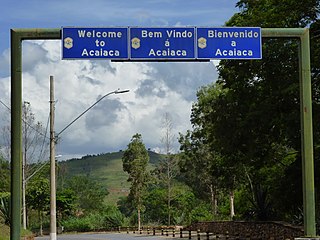
The following is a list of symbols of the Brazilian state of Rio Grande do Norte.

The following is a list of symbols of the Brazilian state of Rio Grande do Norte.
| Type | Symbol | Date | Image |
|---|---|---|---|
| Flag | Flag of Rio Grande do Norte | 3 December 1957 [1] [2] |  |
| Coat of arms | Coat of arms of Rio Grande do Norte | 1909 [1] |  |
| Song | Anthem of Rio Grande do Sul | 3 December 1957 [1] [3] |
| Type | Symbol | Date | Image |
|---|---|---|---|
| Flower | Orchid | 16 May 2019 [4] [5] |  |

Rio Grande do Norte is one of the states of Brazil. It is located in the northeastern region of the country, forming the northeasternmost tip of the South American continent. The name literally translates as "Great Northern River", referring to the mouth of the Potenji River.
Talian, or Brazilian Venetian, is a Venetian dialect spoken primarily in the Serra Gaúcha region in the northeast of the state of Rio Grande do Sul in Brazil. It is also spoken in other parts of Rio Grande do Sul, as well as in parts of Espírito Santo and of Santa Catarina.

Mossoró is the second most populous city in the state of Rio Grande do Norte, Brazil, and also the largest municipality of that state. It is equidistant from Natal, the state capital of Rio Grande do Norte, and from Fortaleza, the capital of the state of Ceará. It is also in the heart of Brazil's salt production area. Situated in the Oeste Potiguar mesoregion, Mossoró is the country's largest land-based petroleum producer.

Caldeirão Grande is a Brazilian municipality in the state of Bahia. Its estimated population as of 2020 was 13,391 inhabitants, up from 12,491 in 2010. It has an area of 458.31 square kilometres (176.95 sq mi). As of 2020, the mayor was Candido Pereira da Guirra Filho.

Portuguese is the official and national language of Brazil being widely spoken by most of the population. Brazil is the most populous Portuguese-speaking country in the world, with its lands comprising the majority of Portugal's former colonial holdings in the Americas.

Estrela Velha is a municipality in the state of Rio Grande do Sul, Brazil. It was raised to municipality status in 1995, the area being taken out of the municipality of Arroio do Tigre.

Machadinho is a municipality in the state of Rio Grande do Sul, Brazil. It was raised to municipality status in 1959, the area being taken out of the municipality of Lagoa Vermelha. As of 2020, the estimated population was 5,427.
Muitos Capões is a municipality in the state of Rio Grande do Sul, Brazil. It was raised to municipality status in 1992, the area being taken out of the municipalities of Vacaria, Lagoa Vermelha and Esmeralda. As of 2020, the estimated population was 3,173.

São Vendelino is a municipality in the state of Rio Grande do Sul, Brazil. It was raised to municipality status in 1988, the area being taken out of the municipality of Bom Princípio.

Bom Jesus is a neighbourhood (bairro) in the city of Porto Alegre, the state capital of Rio Grande do Sul, in Brazil, with a population of 11202, and covering an area of 2.6 million km². It was created by Law 5799 from December 15, 1986, but had its limits modified by Law 6594 from January 31, 1990.
Pinhal da Serra is a municipality in the state of Rio Grande do Sul in the Southern Region of Brazil. It was raised to municipality status in 1996, the area being taken out of the municipality of Esmeralda.
Jacuizinho is a municipality in the state of Rio Grande do Sul in the Southern Region of Brazil. It was raised to municipality status in 1997, the area being taken out of the municipalities of Salto do Jacuí and Espumoso.

Events in the year 1957 in Brazil.

Eann Styvenson Valentim Mendes more commonly known as Styvenson Valentim is a Brazilian politician, as well as a captain in the Brazilian military police. Although born in Acre, he has spent his political career representing Rio Grande do Norte, having served as federal senator since 2019.

The flag of Pernambuco is one of the official symbols of the Brazilian state of Pernambuco. It is a bicolor pennant, blue and white, with the colors broken horizontally into two unequal sections, with blue in the upper and larger rectangle, the rainbow composed of three colors, red, yellow and green, with a star in above and below the sun, inside the semicircle, both in yellow, and, in the lower and smaller white rectangle, a red cross.

A Xis, also known as a Xis gaúcho, is a sandwich from the Brazilian state of Rio Grande do Sul that was inspired by the American cheeseburger. The sandwich consists of meat, cheese, lettuce, tomato, peas, corn, and mayonnaise served on a bread bun larger than a typical hamburger bun. The meat used can vary with some common choices being a beef patty, chicken hearts, fish fillets, chicken breast, calabresa sausage, bacon, or fried eggs. Vegetarian variants that use meat alternatives exist. The sandwich is pressed on a grill and served hot.

The flag of Paraíba is the official flag of the Brazilian state of Paraíba. The initial version of the modern day flag was first adopted on 25 September 1930 by State law no. 704.